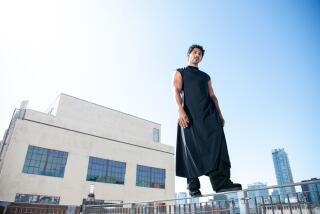Well-Worn Words Were the Fabric of Her Life
- Share via
Veteran Ohio newspaper fashion editor Janet McCue can tell you exactly what New York designers mean when they talk about “regional fashion press.”
“It means everyone who doesn’t get a front-row seat,” said McCue, referring to the seating charts at runway shows, bane of the eternally insulted out-of-town corps of fashion press, which almost always takes a back seat to magazine editors and store buyers. On behalf of those regional writers, McCue accepted a special award from the Council of Fashion Designers of America on Thursday in New York. The award acknowledges the contributions to fashion journalism from the scribes in the hinterlands (which usually means outside Manhattan).
After covering fashion for 20 years at the Cleveland Plain Dealer, McCue retired in April. A youthful 64, she spent 37 of her 47 years in journalism there.
Through dozens of trips to Paris, Milan, London and New York, McCue has interpreted runway and local fashion for the hometown readers, often with a large dose of humor. Minutes before leaving her new home in Las Vegas for the awards Tuesday, McCue reflected on the significant changes she documented in her weekly section, Style.
“In my 20 years, you didn’t know what was going to influence fashion. Designers would comb the streets looking for kids, or hang out in bars for the next trend,” she said. “It really made fashion completely different and much, much more flexible. It gave people many more choices.
“I grew up in an era when you didn’t have choices. When the mini first came out, if you were 25 pounds overweight and 50 years old, you wore a mini anyway,” she said.
McCue has weathered some of fashion’s big ideas that weren’t necessarily big sellers: androgyny in the ‘80s and grunge and deconstruction in the ‘90s.
“During deconstruction, it was very difficult to explain why there were three sleeves in a jacket, or why you would pay $800 for a skirt with a ripped-out hem.
“In my time, I also saw Armani jackets paired with jeans. You wouldn’t dream of doing that before. It’s really exciting to see. . . . Gosh,” she said as a quick aside, “I didn’t realize how much I loved this job . . . just how far designers will go.”
The other major changes she’s seen in fashion include the adaptation of work wear as street wear; the relaxing of rules and casual business dressing; the influence of music and television; and Gap-style mass retailing, which she called “fast-food fashion.”
“I’ve come to see how much fashion influences every facet of American life. The first lady is judged on her haircut. Marcia Clark had to get a haircut before she had any credibility on TV.
“When people say they aren’t interested in fashion, I say they can’t help being interested in fashion. For example, sports is so closely affiliated with fashion that we actually borrow the look of uniforms and sportif motifs.”
Cleveland stores often wouldn’t carry the most extreme looks, so McCue was challenged “to keep my readers feeling like they were part of the whole scene, but sift it out so that it didn’t seem above them.
“My approach has always been humor--the really funny, wacky, hysterical side of this business,” she said. “I wanted my readers to have as much fun as I did.”






